What Exactly Is Pâté, And How Do You Use It?
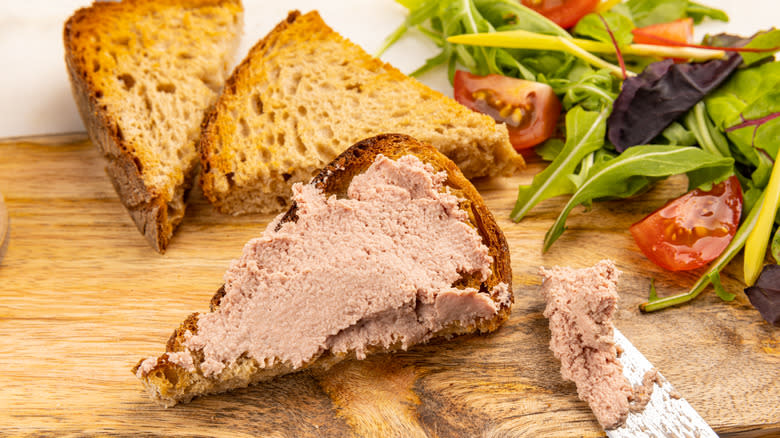
We may receive a commission on purchases made from links.
Pâté is a dish that sounds fancy, but it's actually evolved from humble roots. It dates back to the 11th century, when innovative cooks created it to make use of every part of an animal. Though the French often get credit for pâté, the Romans and the Greeks also produced and sold it. French cooks of the time relied on pâté as a means of preserving meat so it could be enjoyed all year round. These days, pâté is considered something of a delicacy in the United States, but it's a staple in French cuisine. It's estimated that about a quarter of French citizens enjoy pâté once a week, while a staggering amount -- nearly three times that -- eat it about once a month.
For less adventurous eaters, pâté might seem like swanky food reserved for fancy restaurants and served to the rich and famous. But it's a versatile dish that can be served as an appetizer, a light meal when paired with crusty bread and a salad, or as a tasty charcuterie board accoutrement. Whether you're a pâté connoisseur or newbie foodie, learning the basics of pâté will open up a world of flavor and texture. Here's what you need to know to make, buy, and enjoy pâté.
Read more: The Best Meat For Your Charcuterie Board Isn't One You'd Expect
What Is Pâté Made Of?
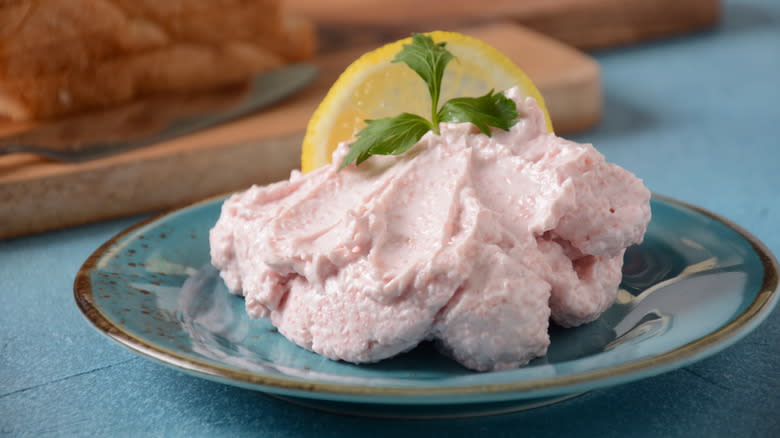
The origins of pâté may have been quite humble, but it's evolved over time, with French cooks experimenting with additional ingredients like herbs, spices, bread, and alcohol. The primary function of this now-refined dish is no longer the preservation of meat and fish, but rather to please the palates of those who enjoy a decadent and delicious dish.
Liver is what pâté is most commonly made of, but the tongue, kidneys, and heart of an animal may also be used to prepare it. The organs used to make pâté might remain the same, but the animals they come from can vary greatly. Chicken liver pâté may be among the standard most pâté lovers are accustomed to, but it can also be made with beef, pork, duck, goose, fish, or game meat like rabbit, venison, and pheasant. Even vegetables like mushrooms can be transformed into pâté.
The organ and muscle meat is ground and then combined with vegetables, such as onions and garlic, as well as fresh spices and herbs, including bay leaves, thyme, and black pepper. A splash of a spirit like brandy or Cognac can be added for additional flavor. This creates a flavorsome spread or paste.
How To Make Pâté
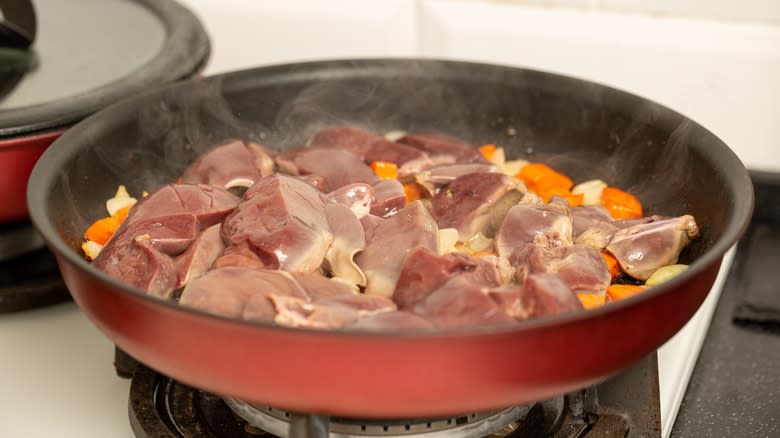
In its simplest form, pâté is essentially a meatloaf that's traditionally made by taking the ground meat and other aforementioned ingredients and packing this mixture into a terrine or pastry dough. Once molded, it's then wrapped tightly in caul fat — the thin, white lining of an animal's internal organs — and baked in the oven until cooked through.
Today, most cooks prepare pâté by simmering their meat of choice in a pan, along with aromatics like onion and garlic. Once the meat or poultry is cooked through and the vegetables soften, it is transferred to a food processor or blender and processed until it's smooth and creamy. It's not uncommon to then bind your pâté by adding a panade — or, a bread-and-milk combination. But either way, once the mixture has been spread into a terrine or other container, it's placed in the fridge to chill.
What Does Pâté Taste Like?
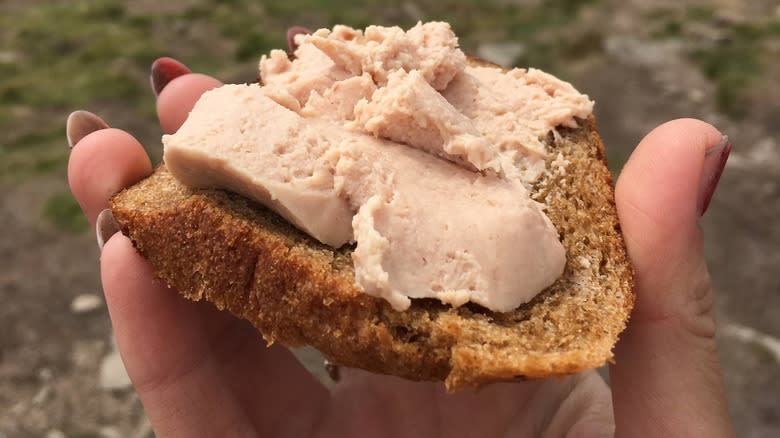
There's a reason so many people don't like the taste of liver. It has an earthy, slightly bitter flavor that, when coupled with its chewy, dry texture, can be off-putting to even adventurous eaters. The problem is the liver that has tainted so many childhood dinner memories was likely improperly prepared. When it's overcooked, liver's earthy flavor can become overpowering and strong. This an easy way to make a good food taste bad — and since liver is typically the base flavor for many pâtés, it's likely contributed to pâté's reputation as an acquired taste.
Pâté will naturally take on the flavor of the meats used to make it, so each variety will have a different flavor palate. But while it's buttery from the fats cooked with it, pâté also benefits greatly from the aromatic vegetables, herbs, and spices added to it. Its flavor, then, should be rich, savory, and well-seasoned. However, some less refined pâtés might contain nuts and dried fruits, which further adds to the paste's depth of flavor while making for a more complex texture.
How To Serve Pâté
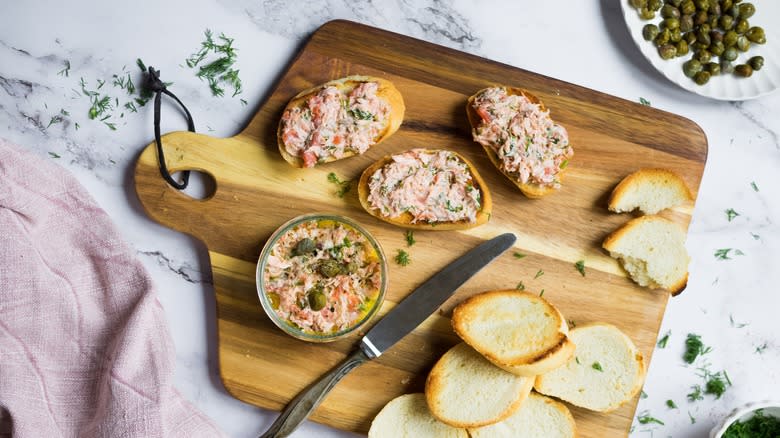
If you want to level up any event involving food, add pâté to the menu, and you'll have instant elegance. Pâté's versatility makes it the perfect dish for everything from casual get-togethers to the fanciest dinners — so it will instantly give your meal a little zhuzh.
Perhaps the most common way to enjoy pâté is as an appetizer. You've likely seen it served with toast points or crusty bread, or as a featured item on a cheese and charcuterie board. Its rich, creamy flavor pairs wonderfully with crunchy cornichons or a zesty stone ground mustard. Add a bit of pâté to your favorite salad for an easy protein boost, or spread a thick layer on slices of bread next time you make your favorite sandwich. It also makes a decadent dip for chopped or sliced veggies — and if you're feeling bold, you can even stuff peppers with pâté for an unexpected side dish. There are numerous other creative uses for pâté ranging from adding it to scrambled eggs to mixing it into softened butter for an amazing compound butter.
Lastly, if you're serving pâté with wine, choose one with a big, bold flavor and lots of tannins. A lighter-flavored wine will be easily overpowered by the taste of the pâté.
Where To Buy Pâté

Pâté was once a food most people only enjoyed in white tablecloth restaurants along with dishes like escargot and duck confit. But today's food lovers want to enjoy these delicacies at home and as frequently as they'd like. As such, a quick internet search will give you dozens of simple pâté recipes you can easily whip up in your own kitchen. But if you're not in your make-it-at-home era, there are numerous options for purchasing prepared, store-bought pâté.
The price, whether it's in a refrigerated package, jarred, canned, or fresh from the deli, can vary. Williams Sonoma sells a duck mousse and pâté trio set totaling well over a pound online for $79.95. It can be delivered to your door chilled, similarly to options from high-end brands like Dufour Gourmet and D'Artagnan. The former offers an 8-ounce liver pâté with pistachios for $13.99, while $11.99 will get you the latter's 9-ounce country-style pâté. Even Amazon has gotten in on the mail-order-pâté game, including 4.5-ounce cans of four different flavors for $29.99. If you don't want to wait for shipping, you can find more immediate pâté options in grocery stores like Harris Teeter, Wegmans, and Whole Foods. These products are typically located alongside specialty meats and fancier cheeses.
Pâté is one canned meat we recommend stocking in your pantry. In addition to lasting longer than the refrigerated variety, it's a relatively inexpensive way to elevate a meal.
Is Pâté Different Than A Terrine?
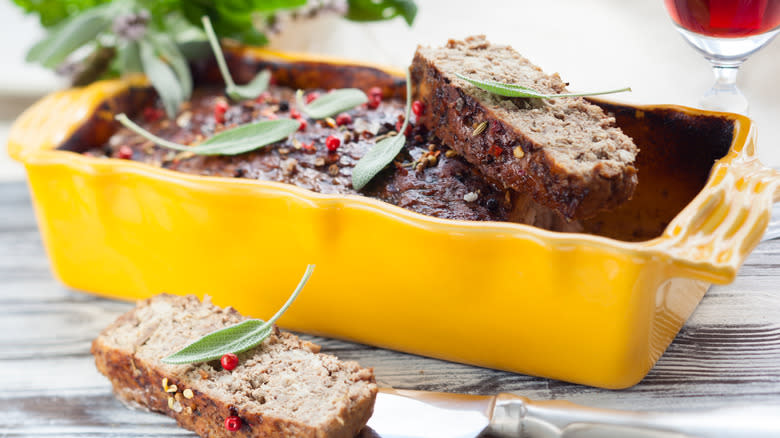
In food and cooking, there are some words that are so closely related that people use them interchangeably even though they're not quite the same thing. Chicken broth and chicken stock are two completely different foods used in such similar ways that many don't know the difference. You can also include sweet potatoes and yams, jam and jelly, and pâté and terrine in this mix.
The term terrine has two meanings. It can be used to describe the actual loaf-shaped dish that some pâtés and other foods are baked and served in. Terrine can also be used to reference pâtés with a firm, sturdy texture made with larger pieces of meat, like course-grained pâté. The term pâté, then, is typically used to reference finely-ground pâtés with a creamy or smooth texture.
Some pâtés can even be prepared without baking, as mentioned. For many chicken liver pâtés, for example, the meat is sauteed in a pan on the stovetop and then blended until it's smooth. These pâtés could technically be spread into a terrine for chilling and serving, but they're not actually terrines. In short, all terrines are pâtés but not all pâtés are terrines.
How To Store Pâté
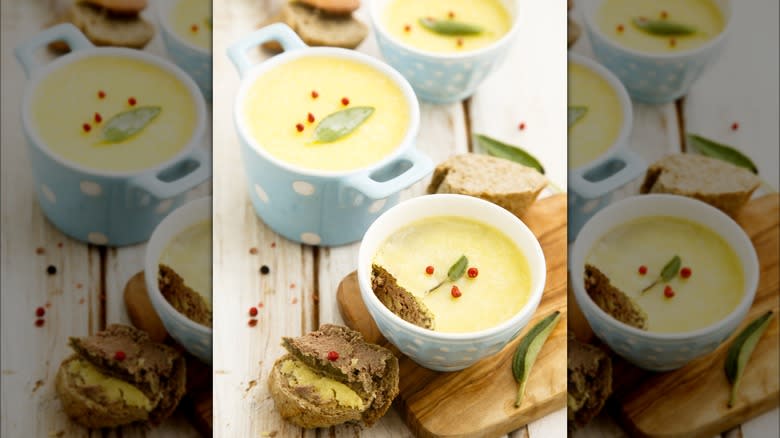
Storing your pâté properly, whether it's homemade or store bought, is integral to extending its shelf life and keeping it fresh. While from-the-deli pâté should, of course, be refrigerated, you should check the label of canned or jarred pâté for specific storage instructions — though most can be stored in your pantry at room temperature for a long period of time. Once you open canned or jarred pâté, however, it should be refrigerated and consumed within 7 to 10 days.
Homemade pâté is a different story. Because it doesn't contain the additives and preservatives of the store-bought variety, it doesn't have a long shelf life. Most can be covered and stored in the fridge for a day or two, but there is a way to make homemade pâté last even longer, should you wish to use it at a later date. Once you transfer your homemade pâté into a ramekin or terrine, you can seal it in the container by covering the surface with melted butter. The butter will harden when chilled, creating a seal of sorts that will keep the pâté from going bad.
Wrap the butter-sealed pâté tightly in plastic wrap, and it will last in the fridge for up to two weeks. But after you've broken this seal, you should enjoy your pâté within one week.
Read the original article on Tasting Table.

